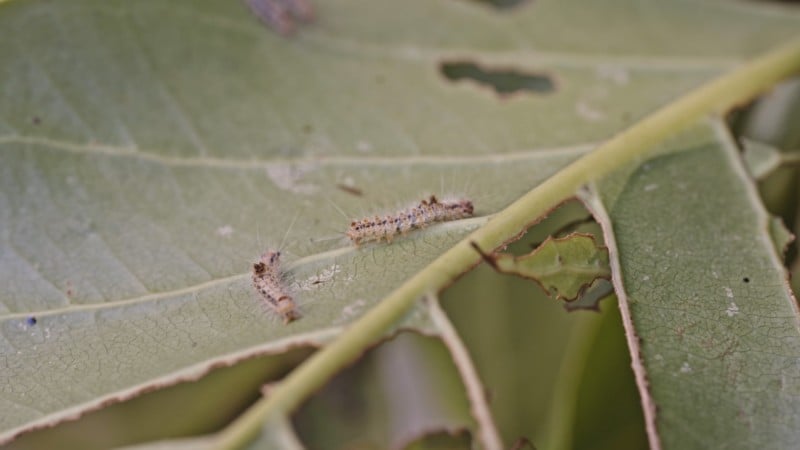Scientists are Fighting a Destructive Bug with Targeted Pesticide Drone Strikes
Scientists in the Maldives are fighting a particularly devastating species of caterpillar by using targeted pesticide drone strikes, evolving a previously extremely manual and imprecise method of dealing with the problem.
Successfully combating the pest — called Euproctis fraternal or more colloquially known as the hairy caterpillar — is necessary for a few reasons. Mainly, the caterpillar is extremely destructive to the local environment. They cause extreme damage to and can even kill the local Indian Almond trees, which are a critical species at the core of the Maldives’ ecosystem.
But in addition to that, the caterpillars are threatening to humans. The hairs on the caterpillar contain a toxin that causes severe rashes and blistering when it comes in contact with human skin. It can be so bad as to necessitate hospitalization. The problem is so bad that locals will close schools and outdoor areas to prevent people from inadvertently making contact with the caterpillars.

Dr. Bart G.J. Knols, a medical entomologist, explains to DJI that the cold-blooded caterpillars are growing in number due to the rising temperatures of the planet, which makes them a danger to both the environment and the locals.
The main method for dealing with the caterpillars in the areas they affect is to spray the environment down with pesticides. The landmass of the Maldives is made up of a combination of coral and fish waste, and that very loose structure is held together by trees. Without the trees, the island wouldn’t hold together. That makes leaving the caterpillars to do damage untenable, but equally, it is not a solution to remove the trees.
“To date, the response on every single island has been to spray large volumes of pesticides or chop down entire trees. That’s how far we have got with this problem, which is ridiculous,” Dr. Knols explains.
“If you start chopping down trees, then you lose that benefit of the roots keeping everything together. But some resorts are seeing infestations get so heavy that they simply don’t have another option, which leads to a cascade of negative effects.”
Even if pesticides are used instead, the traditional method is extremely imprecise and leaves many caterpillars in place, is expensive, and the chemicals often bleed out onto the ground or are blown into outlying areas. It’s not a good solution.
![]()
To address the problem, Dr. Knols is experimenting with the use of drones that are capable of delivering targeted pesticide drone strikes above the canopy. Starting with the DJI Agras T30 — a heavy-duty 30-liter capacity aerial platform designed for agriculture — Knoles is working with researchers from McGill University in Canada to eventually incorporate multispectral data and AI to make every spraying mission as targeted as possible.
“Ideally we want to seek out infestations in the trees at a very early stage. We don’t want to wait until we’ve got large caterpillars chewing up entire leaves because by then they have big hairs and the problem has already started,” Dr. Knols says. “We want to be ahead of the game, which means using multispectral analysis to monitor infestations.”
The strategy takes advantage of the caterpillar’s biochemistry which can be seen through a multispectral camera system.
![]()
“So the idea is that we will be spraying when the problem is not even there yet, skipping trees that don’t have any caterpillars on them and using minimal amounts of pesticide. It will certainly be an interesting contrast with what we do at the moment.”
![]()
![]()
The team is working on training a model based on multispectral image data which is expected to take about a year to develop. Once done, it will be used in conjunction with a mist of neem oil — which is a botanical pesticide — mixed with a small amount of cypermethrin and only apply it exactly where it is needed. Not only is this better for the environment than typical pesticides, the method uses far less of it and only where it is needed instead of a blanket application.
![]()
![]()
“It takes time before this sort of method hits the mainstream pest control market. People live with dogmas and to change the market and the attitude of people that are involved takes time,” Dr. Knols says.
“But I think the momentum certainly is there. The world is starting to realize that we not only have problems with climate change, but we have major problems with the collapse of biodiversity globally. And we simply have to move away from the way we have done things in the past. We have no choice.”
Image credits: DJI